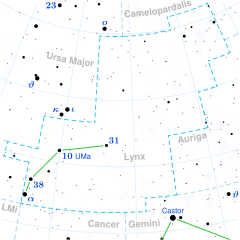| Observation data Epoch J2000 Equinox J2000 | |
|---|---|
| Constellation | Lynx |
| Right ascension | 09h 21m 03.30021s[1] |
| Declination | +34° 23′ 33.2134″[1] |
| Apparent magnitude (V) | +3.14[2] |
| Characteristics | |
| Evolutionary stage | Giant star |
| Spectral type | K7 III[3] |
| U−B color index | +1.95[4] |
| B−V color index | +1.55[4] |
| Astrometry | |
| Radial velocity (Rv) | 37.15[5] km/s |
| Proper motion (μ) | RA: −218.723 mas/yr[1] Dec.: 16.555 mas/yr[1] |
| Parallax (π) | 14.7 ± 0.18 mas[1] |
| Distance | 220.7+2.9 −2.6 ly (67.7+0.9 −0.8 pc)[6] |
| Absolute bolometric magnitude (Mbol) | –2.32 ± 0.13[7] |
| Details | |
| Mass | 1.52±0.077[8] M☉ |
| Radius | 58.15+0.73 −0.75[9] R☉ |
| Luminosity | 621.1±15.8[8] L☉ |
| Surface gravity (log g) | 1.06±0.04[8] cgs |
| Temperature | 3,881±20[8] K |
| Metallicity [Fe/H] | −0.26±0.05[8] dex |
| Rotational velocity (v sin i) | 6.4[5] km/s |
| Age | 1.4[10] Gyr |
| Other designations | |
| Database references | |
| SIMBAD | data |
Alpha Lyncis (α Lyn, α Lyncis) is the brightest star in the northern constellation of Lynx with an apparent magnitude of +3.13.[4] Unusually, it is the only star in the constellation that has a Bayer designation.[10] Based upon parallax measurements, this star is located about 220 light-years (67 parsecs) from the Earth.[1]
Characteristics
This is a red giant star that has exhausted the hydrogen at its core and has evolved away from the main sequence. It has expanded to about 58 times the Sun's radius[9] and it is emitting roughly 621 times the luminosity of the Sun. The estimated effective temperature of the star's outer envelope is 3,881 K,[8] which is lower than the Sun's effective temperature of 5,778 K, and is giving Alpha Lyncis an red-orange hue that is characteristic of late K-type stars.[12]
Alpha Lyncis is a suspected small-amplitude red variable star[13] that changes apparent magnitude from +3.17 up to +3.12.[14] This variability pattern typically occurs in stars that have developed an inert carbon core surrounded by a helium-fusing shell, and suggests that Alpha Lyncis is starting to evolve into a Mira variable.[10]
References
- ^ a b c d e Vallenari, A.; et al. (Gaia collaboration) (2023). "Gaia Data Release 3. Summary of the content and survey properties". Astronomy and Astrophysics. 674: A1. arXiv:2208.00211. Bibcode:2023A&A...674A...1G. doi:10.1051/0004-6361/202243940. S2CID 244398875. Gaia DR3 record for this source at VizieR.
- ^ Ducati, J. R. (2002). "VizieR Online Data Catalog: Catalogue of Stellar Photometry in Johnson's 11-color system". CDS/ADC Collection of Electronic Catalogues. 2237. Bibcode:2002yCat.2237....0D.
- ^ Morgan, W. W.; Keenan, P. C. (1973). "Spectral Classification". Annual Review of Astronomy and Astrophysics. 11: 29–50. Bibcode:1973ARA&A..11...29M. doi:10.1146/annurev.aa.11.090173.000333.
- ^ a b c Johnson, H. L.; et al. (1966). "UBVRIJKL photometry of the bright stars". Communications of the Lunar and Planetary Laboratory. 4 (1): 99. Bibcode:1966CoLPL...4...99J.
- ^ a b Massarotti, A.; et al. (2008). "Rotational and Radial Velocities for a Sample of 761 HIPPARCOS Giants and the Role of Binarity". The Astronomical Journal. 135 (1): 209–231. Bibcode:2008AJ....135..209M. doi:10.1088/0004-6256/135/1/209.
- ^ Bailer-Jones, C. A. L.; Rybizki, J.; Fouesneau, M.; Demleitner, M.; Andrae, R. (2021). "Estimating Distances from Parallaxes. V. Geometric and Photogeometric Distances to 1.47 Billion Stars in Gaia Early Data Release 3". The Astronomical Journal. 161 (3): 147. arXiv:2012.05220. Bibcode:2021AJ....161..147B. doi:10.3847/1538-3881/abd806. S2CID 228063812. Data about this star can be seen here.
- ^ Piau, L.; et al. (2010). "Surface convection and red giants radii measurements". Astronomy and Astrophysics. 526: 100. arXiv:1010.3649. Bibcode:2011A&A...526A.100P. doi:10.1051/0004-6361/201014442. S2CID 118533297. For Mbol, see Table 1.
- ^ a b c d e f Soubiran, C.; Creevey, O. L.; Lagarde, N.; Brouillet, N.; Jofré, P.; Casamiquela, L.; Heiter, U.; Aguilera-Gómez, C.; Vitali, S.; Worley, C.; de Brito Silva, D. (2024-02-01). "Gaia FGK benchmark stars: Fundamental Teff and log g of the third version". Astronomy and Astrophysics. 682: A145. doi:10.1051/0004-6361/202347136. ISSN 0004-6361. Alpha Lyncis' database entry at VizieR.
- ^ a b Baines, Ellyn K.; Armstrong, J. Thomas; Clark, James H.; Gorney, Jim; Hutter, Donald J.; Jorgensen, Anders M.; Kyte, Casey; Mozurkewich, David; Nisley, Ishara; Sanborn, Jason; Schmitt, Henrique R.; Belle, Gerard T. van (October 2021). "Angular Diameters and Fundamental Parameters of Forty-four Stars from the Navy Precision Optical Interferometer". The Astronomical Journal. 162 (5): 198. arXiv:2211.09030. Bibcode:2021AJ....162..198B. doi:10.3847/1538-3881/ac2431. ISSN 1538-3881.
- ^ a b c Kaler, J. B. (May 11, 2005). "ALPHA LYN (Alpha Lyncis) and ALSCIAUKAT (31 Lyncis)". Stars. University of Illinois. Retrieved 2011-12-26.
- ^ "Alpha Lyncis". SIMBAD. Centre de données astronomiques de Strasbourg. Retrieved 2011-12-12.
- ^ "The Colour of Stars". Australia Telescope Outreach and Education. Commonwealth Scientific and Industrial Research Organisation. December 21, 2004. Archived from the original on March 18, 2012. Retrieved 2012-01-16.
- ^ Percy, J. R.; et al. (1994). "Photometric surveys of suspected small-amplitude red variables. III: An AAVSO photometric photometry survey". Publications of the Astronomical Society of the Pacific. 106 (700): 611–615. Bibcode:1994PASP..106..611P. doi:10.1086/133420.
- ^ Kukarkin, B. V.; et al. (1981). "Catalogue of suspected variable stars". Nachrichtenblatt der Vereinigung der Sternfreunde E.V. Bibcode:1981NVS...C......0K.

